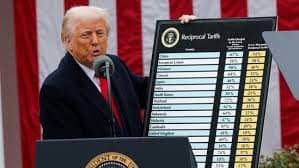
Donald Trump’s announcement of a 26% “discounted” reciprocal tariff on India, made on April 2, 2025, is part of a broader policy to address perceived trade imbalances by imposing tariffs on countries that levy high duties on U.S. goods. This tariff, described as “discounted” because it is roughly half of the 52% tariff Trump claims India imposes on American products, aims to rebalance trade relations. Below is an analysis of its potential impact on India based on available information and economic reasoning.
Economic Impact on India
- Export Reduction:
India’s exports to the U.S., its largest trading partner, could face a decline. In FY24, India exported $77.5 billion worth of goods to the U.S., with key sectors including electronics (15.6%), gems and jewelry (11.5%), pharmaceuticals (11%), machinery (8.1%), and refined petroleum (5.5%). Estimates suggest that the tariffs could reduce India’s exports by $2 billion to $7 billion annually, depending on how broadly they are applied. This could translate to a 3-3.5% drop in total exports to the U.S., potentially shaving 5-10 basis points off India’s GDP growth, currently projected at 6.6% for FY25-26. - Sector-Specific Effects:
- Pharmaceuticals: While initial reports indicate pharmaceuticals may be exempt from these tariffs, any change in this stance could raise costs for India’s generic drug exports, which account for a significant share of the U.S. market. Companies like Sun Pharma, Dr. Reddy’s, and Aurobindo Pharma, with 33-48% of their revenue from the U.S., would face pressure if exemptions are lifted.
- Electronics and IT: The electronics sector, which relies on the U.S. for 32% of its exports, could see higher costs and reduced competitiveness. The IT services sector, though not directly tariffed, might face indirect effects if U.S. clients cut budgets due to broader economic fallout.
- Gems and Jewelry: Gujarat’s diamond industry, a major exporter to the U.S., could lose market share as prices rise, potentially benefiting competitors with lower or no tariffs.
- Textiles and Apparel: This sector might gain a relative advantage over competitors like China (34% tariff) and Vietnam (46% tariff), but higher costs could still dampen demand.
- Automobiles and Auto Parts: A separate 25% tariff on foreign-made autos and parts, effective April 3, could hit Indian exporters like Tata Motors, though the reciprocal 26% tariff adds further pressure on non-exempt components.
- Trade Surplus and Currency:
India’s trade surplus with the U.S. was $36.8 billion in FY24. The tariffs could narrow this surplus, increasing demand for U.S. dollars as imports continue and exports decline. This might weaken the Indian rupee, raising import costs for oil and other essentials, potentially fueling inflation.
Mitigating Factors
- Relative Advantage: India’s 26% tariff is lower than those on competitors like China (34%), Vietnam (46%), and Thailand (36%). This could divert some trade in India’s favor, especially in agriculture (e.g., seafood, rice), where competitors face steeper duties.
- Diversification: India has been diversifying its export markets and supply chains, including via new routes like the Europe-Middle East-U.S. corridor. This could cushion the blow.
- Negotiations: India is pursuing a bilateral trade agreement with the U.S., aiming to double trade to $500 billion by 2030. Preemptive tariff cuts on $23 billion of U.S. imports (e.g., gems, jewelry, auto parts) could soften the impact or secure exemptions.
Broader Implications
- Inflation and Costs: Higher export costs might not fully pass to U.S. consumers due to competition, but Indian firms could see profit margins shrink. Domestically, a weaker rupee could raise living costs.
- Retaliation Risk: India might respond with counter-tariffs, as it did in 2019 against U.S. steel tariffs, escalating tensions. However, a “wait-and-watch” approach is also possible, per economic think tanks like GTRI.
- Global Trade Dynamics: Trump’s policy challenges WTO norms, potentially sparking a broader trade war. India, with strong domestic demand and macroprudential buffers, may weather this better than export-heavy peers, but uncertainty looms.
Outlook
The impact on India appears to be a “mixed bag.” While export-driven sectors face challenges, the limited exposure of India’s GDP to U.S.-centric trade (1.1% in vulnerable sectors) and potential trade diversion offer resilience. The Commerce Ministry’s analysis, ongoing as of April 3, 2025, suggests it’s not a “setback” but requires strategic adaptation. India’s response—whether through negotiation, diversification, or retaliation—will shape the long-term outcome. For now, the immediate effect is likely manageable, with room for diplomatic maneuvering before the tariffs take effect on April 9, 2025.





